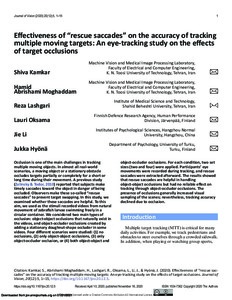Effectiveness of "rescue saccades" on the accuracy of tracking multiple moving targets: An eye-tracking study on the effects of target occlusions
Lauri Oksama; Jukka Hyönä; Reza Lashgari; Shiva Kamkar; Hamid Abrishami Moghaddam; Jie Li
Effectiveness of "rescue saccades" on the accuracy of tracking multiple moving targets: An eye-tracking study on the effects of target occlusions
Lauri Oksama
Jukka Hyönä
Reza Lashgari
Shiva Kamkar
Hamid Abrishami Moghaddam
Jie Li
Scholar One, Inc.
Julkaisun pysyvä osoite on:
https://urn.fi/URN:NBN:fi-fe2021042824306
https://urn.fi/URN:NBN:fi-fe2021042824306
Tiivistelmä
Occlusion is one of the main challenges in tracking multiple moving objects. In almost all real-world scenarios, a moving object or a stationary obstacle occludes targets partially or completely for a short or long time during their movement. A previous study (Zelinsky & Todor, 2010) reported that subjects make timely saccades toward the object in danger of being occluded. Observers make these so-called "rescue saccades" to prevent target swapping. In this study, we examined whether these saccades are helpful. To this aim, we used as the stimuli recorded videos from natural movement of zebrafish larvae swimming freely in a circular container. We considered two main types of occlusion: object-object occlusions that naturally exist in the videos, and object-occluder occlusions created by adding a stationary doughnut-shape occluder in some videos. Four different scenarios were studied: (1) no occlusions, (2) only object-object occlusions, (3) only object-occluder occlusion, or (4) both object-object and object-occluder occlusions. For each condition, two set sizes (two and four) were applied. Participants' eye movements were recorded during tracking, and rescue saccades were extracted afterward. The results showed that rescue saccades are helpful in handling object-object occlusions but had no reliable effect on tracking through object-occluder occlusions. The presence of occlusions generally increased visual sampling of the scenes; nevertheless, tracking accuracy declined due to occlusion.
Kokoelmat
- Rinnakkaistallenteet [19250]
